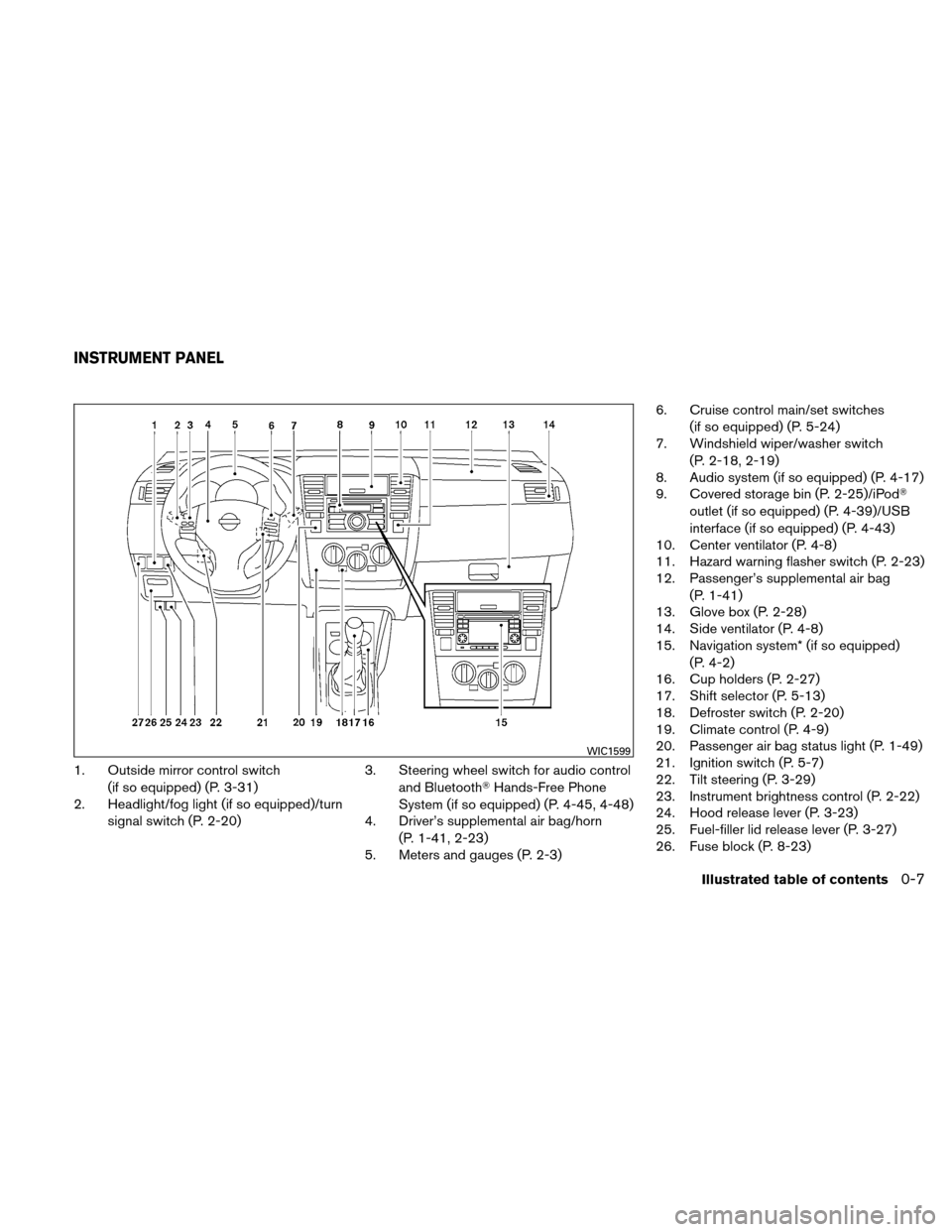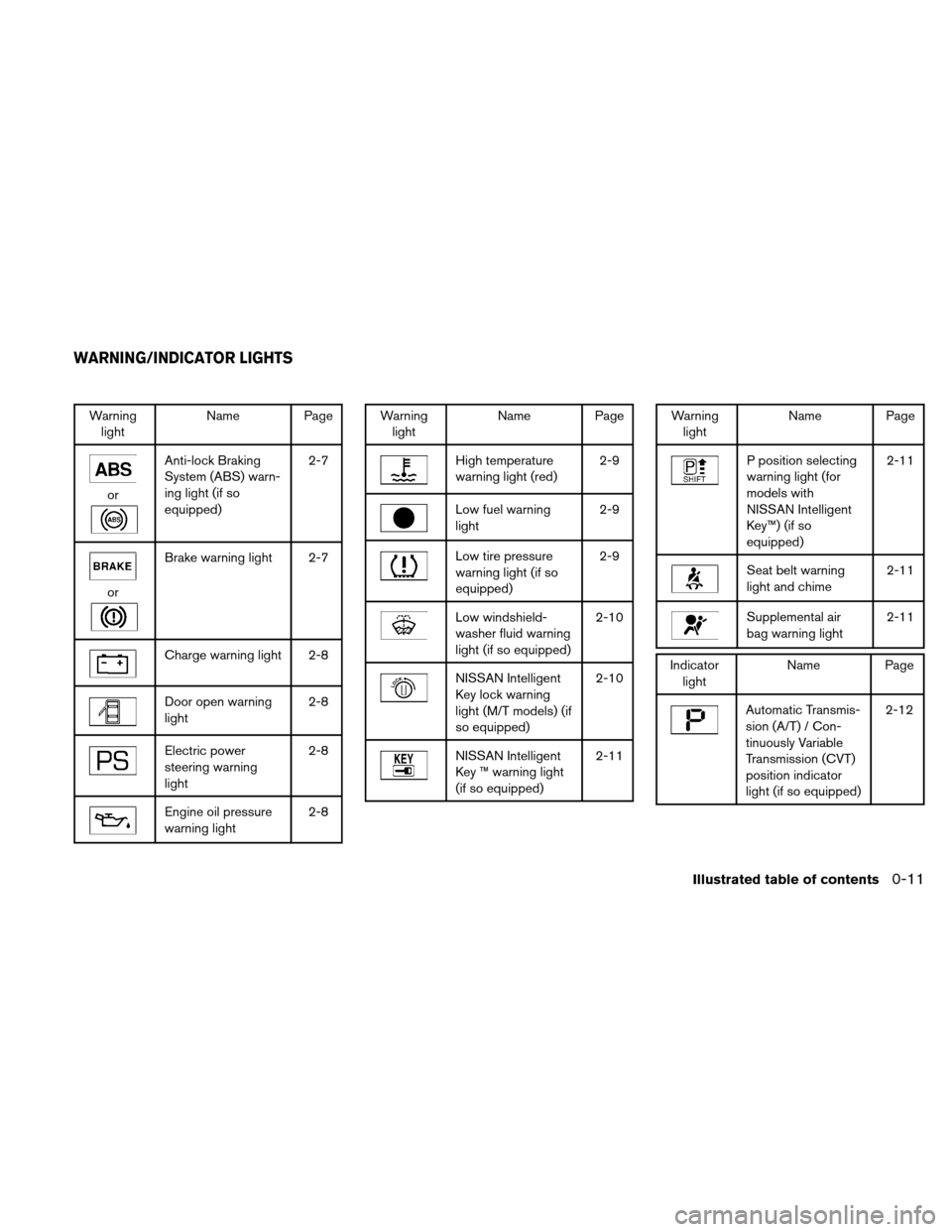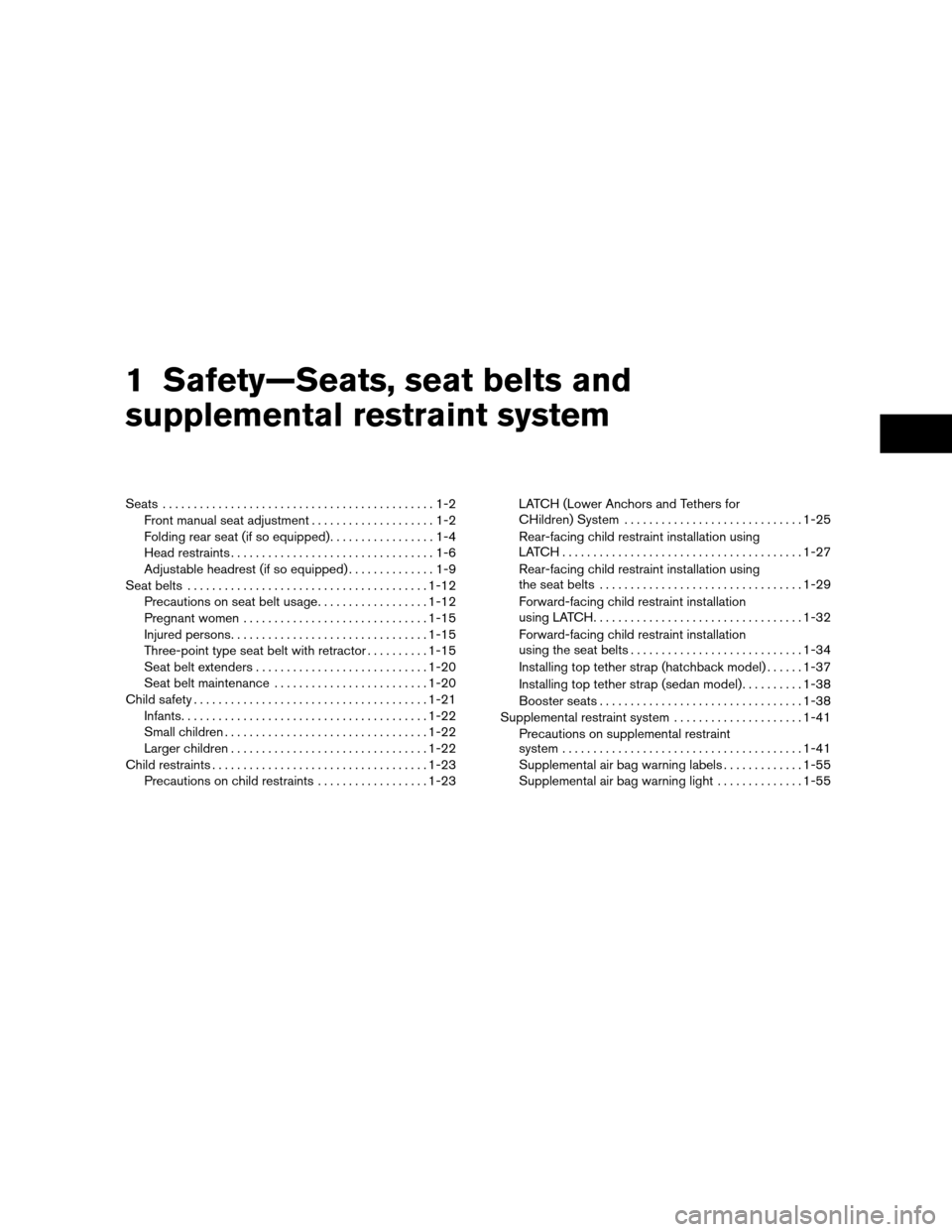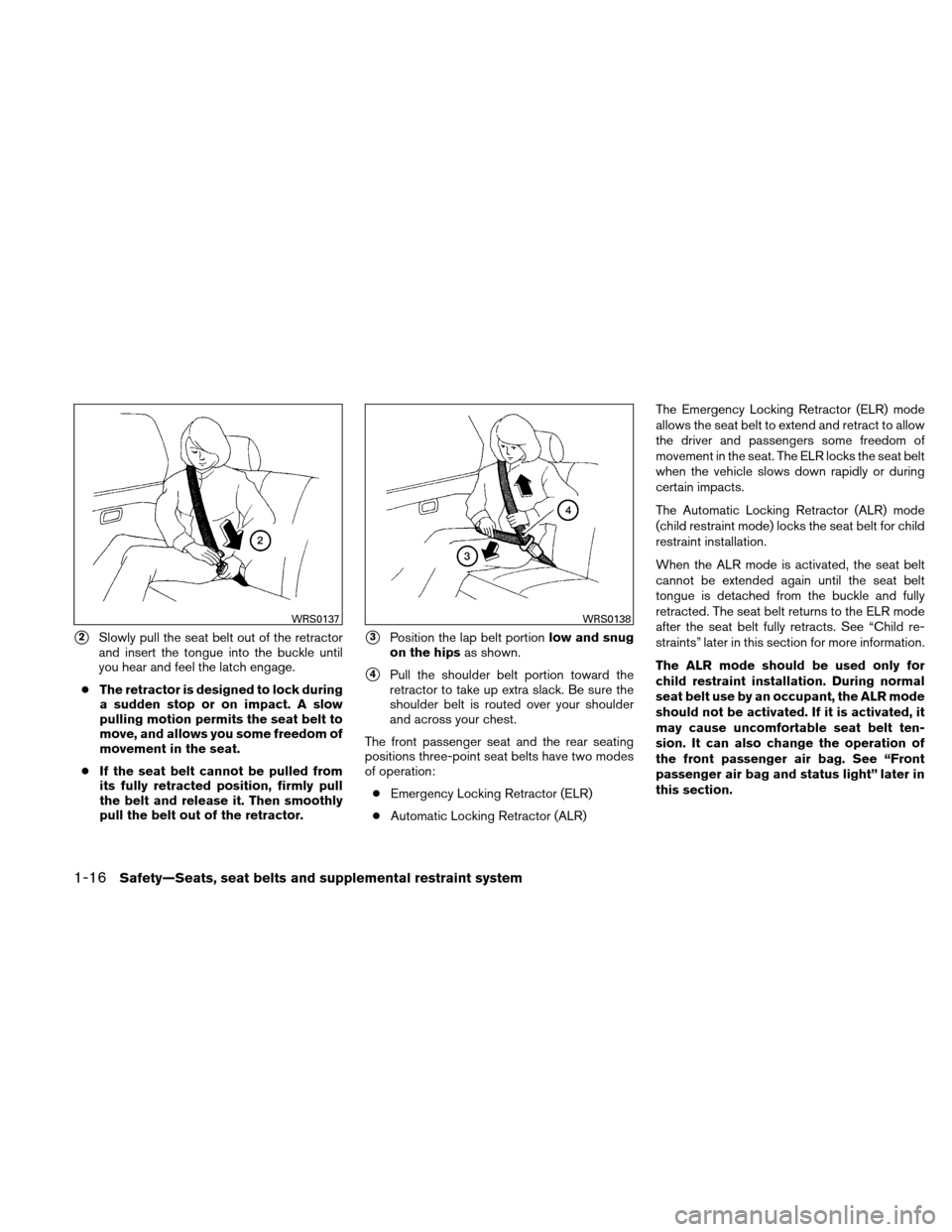Page 8 of 338
0 Illustrated table of contents
Air bags, seat belts and child restraints..............0-2
Exterior front ......................................0-3
Exterior rear .......................................0-4
Passenger compartment ...........................0-6 Instrument panel
...................................0-7
Engine compartment check locations . . . .............0-9
Warning/indicator lights ........................... 0-11
Page 9 of 338
1. Supplemental front-impact air bagmodules (P. 1-41)
2. Roof-mounted curtain side-impact
supplemental air bag (P. 1-41)
3. Front seat-mounted side-impact
supplemental air bag (P. 1-41)
4. Front seat belts (P. 1-12)
5. Head Restraints (P. 1-6)
6. Rear seat belts (P. 1-12)
7. LATCH (Lower Anchors and Tethers for
CHildren) system (P. 1-25)
8. Seat belt with pretensioner (P. 1-54)
9. Seats (P. 1-2)
10. Occupant classification sensor
(pressure sensor) (P. 1-41)
See the page number indicated in paren-
theses for operating details.
WII0157
AIR BAGS, SEAT BELTS AND CHILD
RESTRAINTS
0-2Illustrated table of contents
Page 14 of 338

1. Outside mirror control switch(if so equipped) (P. 3-31)
2. Headlight/fog light (if so equipped)/turn
signal switch (P. 2-20) 3. Steering wheel switch for audio control
and Bluetooth� Hands-Free Phone
System (if so equipped) (P. 4-45, 4-48)
4. Driver’s supplemental air bag/horn
(P. 1-41, 2-23)
5. Meters and gauges (P. 2-3) 6. Cruise control main/set switches
(if so equipped) (P. 5-24)
7. Windshield wiper/washer switch
(P. 2-18, 2-19)
8. Audio system (if so equipped) (P. 4-17)
9. Covered storage bin (P. 2-25)/iPod�
outlet (if so equipped) (P. 4-39)/USB
interface (if so equipped) (P. 4-43)
10. Center ventilator (P. 4-8)
11. Hazard warning flasher switch (P. 2-23)
12. Passenger’s supplemental air bag
(P. 1-41)
13. Glove box (P. 2-28)
14. Side ventilator (P. 4-8)
15. Navigation system* (if so equipped)
(P. 4-2)
16. Cup holders (P. 2-27)
17. Shift selector (P. 5-13)
18. Defroster switch (P. 2-20)
19. Climate control (P. 4-9)
20. Passenger air bag status light (P. 1-49)
21. Ignition switch (P. 5-7)
22. Tilt steering (P. 3-29)
23. Instrument brightness control (P. 2-22)
24. Hood release lever (P. 3-23)
25. Fuel-filler lid release lever (P. 3-27)
26. Fuse block (P. 8-23)
WIC1599
INSTRUMENT PANEL
Illustrated table of contents0-7
Page 18 of 338

Warninglight Name Page
or
Anti-lock Braking
System (ABS) warn-
ing light (if so
equipped) 2-7
or
Brake warning light 2-7
Charge warning light 2-8
Door open warning
light
2-8
Electric power
steering warning
light2-8
Engine oil pressure
warning light
2-8
Warning
light Name Page
High temperature
warning light (red) 2-9
Low fuel warning
light2-9
Low tire pressure
warning light (if so
equipped)2-9
Low windshield-
washer fluid warning
light (if so equipped)2-10
NISSAN Intelligent
Key lock warning
light (M/T models) (if
so equipped)2-10
NISSAN Intelligent
Key ™ warning light
(if so equipped)
2-11
Warning
light Name Page
P position selecting
warning light (for
models with
NISSAN Intelligent
Key™) (if so
equipped) 2-11
Seat belt warning
light and chime
2-11
Supplemental air
bag warning light2-11
Indicator
light Name Page
Automatic Transmis-
sion (A/T) / Con-
tinuously Variable
Transmission (CVT)
position indicator
light (if so equipped) 2-12
WARNING/INDICATOR LIGHTS
Illustrated table of contents0-11
Page 19 of 338
Indicatorlight Name Page
Cruise main switch
indicator light (if so
equipped) 2-12
Cruise set switch
indicator light (if so
equipped)2-12
Front passenger air
bag status light
2-12
High beam indicator
light (blue)2-12
Low temperature
indicator light (blue)2-12
Malfunction Indica-
tor Light (MIL)2-13
Overdrive OFF indi-
cator light (A/T /
CVT models)2-13
Indicator
light Name Page
Security indicator
light 2-13
Slip indicator light (if
so equipped)2-14
Turn signal/hazard
indicator lights2-14
Vehicle Dynamic
Control (VDC) off
indicator light (if so
equipped)2-14
0-12Illustrated table of contents
Page 20 of 338

1 Safety—Seats, seat belts and
supplemental restraint system
Seats............................................1-2
Front manual seat adjustment ....................1-2
Folding rear seat (if so equipped) .................1-4
Head restraints .................................1-6
Adjustable headrest (if so equipped) ..............1-9
Seat belts ....................................... 1-12
Precautions on seat belt usage ..................1-12
Pregnant women .............................. 1-15
Injured persons ................................ 1-15
Three-point type seat belt with retractor ..........1-15
Seat belt extenders ............................ 1-20
Seat belt maintenance ......................... 1-20
Child safety ...................................... 1-21
Infants ........................................ 1-22
Small children ................................. 1-22
Larger children ................................ 1-22
Child restraints ................................... 1-23
Precautions on child restraints ..................1-23LATCH (Lower Anchors and Tethers for
CHildren) System
............................. 1-25
Rear-facing child restraint installation using
LATCH....................................... 1-27
Rear-facing child restraint installation using
the seat belts ................................. 1-29
Forward-facing child restraint installation
using LATCH .................................. 1-32
Forward-facing child restraint installation
using the seat belts ............................ 1-34
Installing top tether strap (hatchback model) ......1-37
Installing top tether strap (sedan model) ..........1-38
Booster seats ................................. 1-38
Supplemental restraint system .....................1-41
Precautions on supplemental restraint
system ....................................... 1-41
Supplemental air bag warning labels .............1-55
Supplemental air bag warning light ..............1-55
Page 31 of 338
PRECAUTIONS ON SEAT BELT
USAGE
If you are wearing your seat belt properly ad-
justed and you are sitting upright and well back in
your seat with both feet on the floor, your chances
of being injured or killed in an accident and/or the
severity of injury may be greatly reduced.
NISSAN strongly encourages you and all of your
passengers to buckle up every time you drive,
even if your seating position includes a supple-
mental air bag.
Most U.S. states and Canadian provinces
or territories specify that seat belts be worn
at all times when a vehicle is being driven.
SSS0136
SEAT BELTS
1-12Safety—Seats, seat belts and supplemental restraint system
Page 35 of 338

�2Slowly pull the seat belt out of the retractor
and insert the tongue into the buckle until
you hear and feel the latch engage.
● The retractor is designed to lock during
a sudden stop or on impact. A slow
pulling motion permits the seat belt to
move, and allows you some freedom of
movement in the seat.
● If the seat belt cannot be pulled from
its fully retracted position, firmly pull
the belt and release it. Then smoothly
pull the belt out of the retractor.�3Position the lap belt portion low and snug
on the hips as shown.
�4Pull the shoulder belt portion toward the
retractor to take up extra slack. Be sure the
shoulder belt is routed over your shoulder
and across your chest.
The front passenger seat and the rear seating
positions three-point seat belts have two modes
of operation: ● Emergency Locking Retractor (ELR)
● Automatic Locking Retractor (ALR) The Emergency Locking Retractor (ELR) mode
allows the seat belt to extend and retract to allow
the driver and passengers some freedom of
movement in the seat. The ELR locks the seat belt
when the vehicle slows down rapidly or during
certain impacts.
The Automatic Locking Retractor (ALR) mode
(child restraint mode) locks the seat belt for child
restraint installation.
When the ALR mode is activated, the seat belt
cannot be extended again until the seat belt
tongue is detached from the buckle and fully
retracted. The seat belt returns to the ELR mode
after the seat belt fully retracts. See “Child re-
straints” later in this section for more information.
The ALR mode should be used only for
child restraint installation. During normal
seat belt use by an occupant, the ALR mode
should not be activated. If it is activated, it
may cause uncomfortable seat belt ten-
sion. It can also change the operation of
the front passenger air bag. See “Front
passenger air bag and status light” later in
this section.
WRS0137WRS0138
1-16Safety—Seats, seat belts and supplemental restraint system